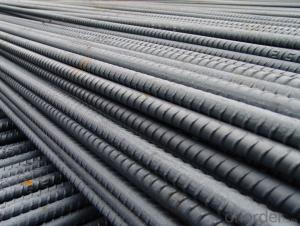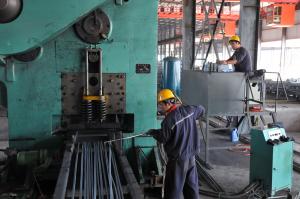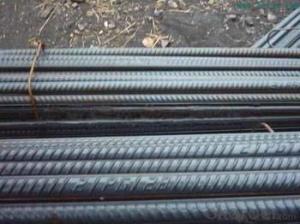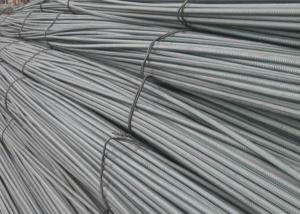Steel Rebar
- Loading Port:
- China Main Port
- Payment Terms:
- TT or L/C
- Min Order Qty:
- 50Tons m.t.
- Supply Capability:
- 1000 Tons Per Day m.t./month
OKorder Service Pledge
OKorder Financial Service
You Might Also Like
Specifications of Steel Rebar:
Standard | GB UK USA | HRB335 HRB400 HRB500 G460B, B500A, B500B,B500C GR40, GR60 | |
Diameter | 6mm,8mm,10mm,12mm,14mm,16mm,18mm,20mm, 22mm,25mm,28mm,32mm,36mm,40mm,50mm | ||
Length | 6M, 9M,12M or as required | ||
Price | Keep lower operating costs so as to offer competitive price for our clients | ||
Label | to be specified by customer, generally, each bundle has 1-2 labels | ||
Application | Building, construction | ||
Invoicing | Actual or Theoretical Weight Basis as buyer’s request. | ||
Type | Hot rolled steel rebar | ||
Brand name | DRAGON | ||
Theoretical weight and section area of each diameter as below for your information:
Diameter(mm) | Section area (mm²) | Mass(kg/m) | Weight of 12m (kg) | Pcs/ton |
6 | 28.27 | 0.222 | 2.664 | 375.38 |
8 | 50.27 | 0.395 | 4.74 | 210.97 |
10 | 78.54 | 0.617 | 7.404 | 135.06 |
12 | 113.1 | 0.888 | 10.656 | 93.84 |
14 | 153.9 | 1.21 | 14.52 | 68.87 |
16 | 201.1 | 1.58 | 18.96 | 52.74 |
18 | 254.5 | 2.00 | 24 | 41.67 |
20 | 314.2 | 2.47 | 29.64 | 33.74 |
22 | 380.1 | 2.98 | 35.76 | 27.96 |
25 | 490.9 | 3.85 | 46.2 | 21.65 |
28 | 615.8 | 4.83 | 57.96 | 17.25 |
32 | 804.2 | 6.31 | 75.72 | 13.21 |
36 | 1018 | 7.99 | 98.88 | 10.43 |
40 | 1257 | 9.87 | 118.44 | 8.44 |
50 | 1964 | 15.42 | 185.04 | 5.40 |
Steel Rebar in warehouse
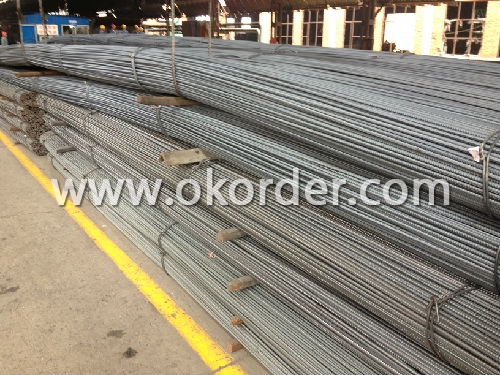
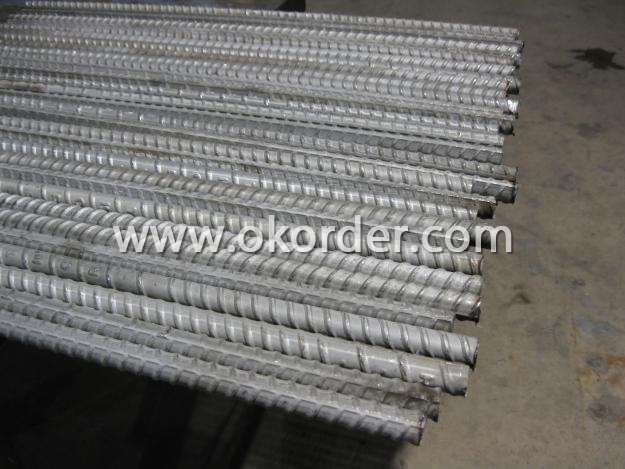
Chemical Composition: (Please kindly find our chemistry of our material based on BS4449 as below for your information)
BS4449 G460B | Chemical Composition | ||||
C | Mn | Si | S | P | |
0.18 | 0.35 | 0.14 | 0.025 | 0.25 | |
Physical capability | |||||
Yield Strength(N/cm²) | Tensile Strength(N/cm²) | Elongation (%) | |||
625 | ≥460 | 18 | |||
Usage and Applications of Steel Rebar:
Deformed bar is widely used in buildings, bridges, roads and other engineering construction. Big to highways, railways, bridges, culverts, tunnels, public facilities such as flood control, dam, small to housing construction, beam, column, wall and the foundation of the plate, deformed bar is an integral structure material. With the development of world economy and the vigorous development of infrastructure construction, real estate, the demand for deformed bar will be larger and larger..
Packaging & Delivery of Steel Rebar:
Packaging Detail: products are packed in bundle and then shipped by container or bulk vessel, deformed bar is usually naked strapping delivery, when storing, please pay attention to moisture proof. The performance of rust will produce adverse effect.
Each bundle weight: 2-3MT, or as required
Payment terms: TT payment in advance or Irrevocable LC at sight.
Trade terms :FOB, CFR, CIF
Delivery Detail: within 45 days after received advanced payment or LC.
Note:
1. Our products are produced according to national standard (GB), if not, supply according to national standards (GB) or agreement as customer required.
2. Other Grade and Standard Deformed Steel Bar we can supply:
Grade: GR40/GR60, G460B/B500A/B500B/B500C,BST500S
Standard: ASTM, BS, DIN
The Minimum Order Quantity of these products is high, and need to be confirmed.
3. We can not only supply Deformed Steel Bar; if you need anything about building materials, please contact us for further information.
4. Please send us your detail specifications when inquire. We will reply to you as soon as possible. We sincerely hope we can establish a long stable business relationship.
- Q: What is the effect of chloride ions on steel rebars?
- The presence of chloride ions in the environment can have a detrimental effect on steel rebars. Chloride ions can penetrate the protective oxide layer on the surface of the steel and react with the iron atoms, leading to the formation of iron chloride compounds. These compounds are highly corrosive and can cause the rebars to rust and eventually weaken. This corrosion process, known as chloride-induced corrosion, can significantly reduce the structural integrity and lifespan of steel rebars, posing a risk to the overall stability of reinforced concrete structures. Therefore, it is crucial to protect steel rebars from chloride exposure through proper design, construction, and maintenance practices to ensure their long-term durability and safety.
- Q: What is the effect of steel rebars on the seismic performance of a structure?
- Steel rebars, also known as reinforcing bars, play a crucial role in enhancing the seismic performance of structures. When subjected to seismic forces, structures experience intense shaking and vibrations. The presence of steel rebars significantly improves the overall strength and ductility of a structure, helping it to withstand and absorb the energy generated during an earthquake. One of the primary effects of steel rebars is their ability to increase the tensile strength of concrete. Concrete is strong in compression but weak in tension. By embedding steel rebars within the concrete, the composite material becomes capable of resisting tensile forces that may arise during an earthquake. This prevents the concrete from cracking or breaking apart, ensuring the structure remains intact and functional. Moreover, steel rebars act as a reinforcement mechanism by distributing the seismic load across the entire structure. During an earthquake, the shaking motion is dispersed throughout the building, reducing the concentration of stress on specific areas. This redistribution of forces helps to maintain the overall stability of the structure, preventing localized failure and collapse. Additionally, the presence of steel rebars enhances the ductility of the structure. Ductility refers to the ability of a material to deform under stress without fracturing. When seismic forces act on a building, the steel rebars provide flexibility and allow for controlled deformation. This plastic behavior helps to dissipate the energy generated during an earthquake, effectively reducing the impact on the structure and minimizing potential damage. Furthermore, steel rebars also contribute to the overall stiffness of the structure. By reinforcing concrete elements such as columns, beams, and walls, the rigidity of the entire system is increased. This stiffness helps to limit the displacement and deformation of the structure, mitigating the risk of structural failure and ensuring the safety of occupants during a seismic event. In summary, the presence of steel rebars in a structure significantly improves its seismic performance. They enhance the tensile strength of concrete, distribute seismic load, improve ductility, and increase overall stiffness. These effects collectively enhance the structure's ability to resist and withstand the forces generated during an earthquake, ensuring its integrity and the safety of its occupants.
- Q: How do steel rebars affect the overall fire safety of concrete structures?
- The overall fire safety of concrete structures can be affected by steel rebars, both positively and negatively. On the positive side, steel rebars can strengthen the fire resistance of concrete structures. Concrete has low thermal conductivity, which means it doesn't easily conduct heat. However, exposure to fire can cause concrete to crack and lose its integrity. Steel rebars help address this issue by providing additional tensile strength, acting as reinforcement to prevent cracking and collapse under intense heat. On the flip side, steel rebars can pose challenges to fire safety. Steel is a good heat conductor, transferring heat from the fire to other parts of the structure. This can weaken the concrete and compromise overall fire safety. Furthermore, steel rebars can expand under high temperatures, potentially causing more cracking and damage to the concrete. To improve fire safety in concrete structures with steel rebars, several measures can be taken. Applying fire-resistant coatings or fireproofing materials on the rebars can minimize heat transfer to the surrounding concrete. Installing fire-resistant insulation or fire barriers around the rebars can also offer additional protection. Proper design and construction practices, including appropriate spacing and size of rebars, are crucial to maintaining the fire resistance of the concrete structure. In conclusion, steel rebars have a significant impact on the fire safety of concrete structures. While they enhance fire resistance, challenges such as heat transfer and expansion must be addressed. By implementing appropriate measures and construction practices, the negative effects of steel rebars on fire safety can be minimized, resulting in improved fire resistance for concrete structures.
- Q: How do steel rebars affect the overall load distribution of concrete structures?
- Steel rebars play a critical role in the load distribution of concrete structures. They enhance the overall strength and durability of the concrete by providing reinforcement. When concrete is poured, it is strong in compression but weak in tension. Steel rebars are embedded within the concrete to counterbalance this weakness and distribute the load more evenly. The presence of steel rebars helps to prevent cracks and structural failures by absorbing and distributing the tensile forces exerted on the concrete. As the load is applied to the structure, the steel rebars effectively transfer the tension forces to the surrounding concrete, which is highly resistant to compression. This load transfer mechanism results in a more balanced distribution of forces throughout the structure. Furthermore, the use of steel rebars increases the overall stiffness of the concrete structure. By resisting deformation, the rebars help to maintain the structural integrity and prevent excessive deflection under load. This is particularly important in large-scale concrete structures such as bridges, high-rise buildings, and dams, where the load distribution needs to be carefully managed to ensure stability. In summary, steel rebars significantly influence the load distribution of concrete structures by reinforcing the concrete and enhancing its tensile strength. They work in synergy with the concrete to evenly distribute and transfer the load, preventing cracks and structural failures. The combination of steel rebars and concrete creates a robust and reliable structural system capable of withstanding the applied loads and ensuring long-term safety.
- Q: Can steel rebars be used in the construction of sports stadiums or arenas?
- Yes, steel rebars can be used in the construction of sports stadiums or arenas. Steel rebars are a commonly used reinforcement material in concrete structures, including stadiums and arenas. They provide strength, durability, and structural integrity to the concrete, making them suitable for the demanding requirements of sports facilities.
- Q: How long do steel rebars typically last?
- Steel rebars typically have a long lifespan and can last for several decades. The exact duration of their lifespan depends on various factors, such as the quality of the rebar, the environmental conditions it is exposed to, and the maintenance practices implemented. Generally, steel rebars are designed to be resistant to corrosion, which is one of the main factors that can affect their longevity. However, over time, rebars may experience some corrosion due to exposure to moisture, chemicals, or other corrosive agents. This can potentially reduce their lifespan. Regular inspections, maintenance, and the application of protective coatings can help extend the lifespan of steel rebars. With proper care, steel rebars can typically last 30 to 50 years or even longer.
- Q: How do steel rebars resist fatigue and cyclic loading?
- Steel rebars are specifically designed to resist fatigue and cyclic loading due to their unique properties and design. Firstly, steel rebars are made from high-strength steel, which has excellent resistance to fatigue. High-strength steel has a higher yield strength and ultimate tensile strength compared to regular steel, allowing it to withstand repetitive loading without undergoing significant deformation or failure. This property helps rebars endure cyclic loading without experiencing fatigue failure. Moreover, steel rebars are reinforced with rib patterns along their surface. These ribs increase the surface area, enhancing the bond between the rebar and surrounding concrete. This increased bond strength helps to distribute the cyclic loads more evenly, reducing the localized stress concentration. By distributing the loads, the rebars are better able to resist fatigue and cyclic loading. Additionally, rebars are often designed with a specific diameter and spacing to optimize their load-carrying capacity and resist fatigue. The design takes into consideration the anticipated cyclic loads, ensuring that the rebars are adequately spaced and sized to handle the expected stresses. The spacing between rebars also allows for proper concrete flow and consolidation during construction, further enhancing the overall performance and resistance to fatigue. Furthermore, proper installation and quality control during construction play a crucial role in ensuring the rebars' resistance to fatigue and cyclic loading. Adequate concrete cover, proper placement within the concrete, and secure anchoring of the rebars all contribute to their ability to withstand cyclic loading over time. In summary, steel rebars resist fatigue and cyclic loading through their high-strength steel composition, ribbed surface patterns, optimized spacing and diameter, and proper installation techniques. These features work collectively to enhance their load-carrying capacity, distribute loads more evenly, and minimize stress concentration, resulting in improved resistance to fatigue and cyclic loading.
- Q: How do steel rebars affect the overall safety of construction projects?
- The overall safety of construction projects is greatly enhanced by steel rebars, which play a crucial role. One of the main benefits of steel rebars is their ability to reinforce concrete structures, making them stronger and more resistant to different types of forces like tension, compression, and bending. This reinforcement significantly improves the structural integrity of buildings, bridges, and other constructions, thereby reducing the risk of collapse or failure. In addition to their reinforcing properties, steel rebars also possess excellent ductility, meaning they can deform without breaking under extreme loads. This characteristic allows rebars to absorb and distribute the energy produced during earthquakes, high winds, or heavy impacts, thereby preventing sudden and catastrophic structural failures. Moreover, steel rebars can withstand high temperatures and fire, ensuring that they retain their strength and integrity in the event of a fire, which is crucial for the safety of occupants. Furthermore, steel rebars are highly resistant to corrosion, a common issue in construction projects. Corrosion gradually weakens the structure by deteriorating the reinforcement over time. However, using steel rebars significantly reduces the risk of corrosion, thus extending the lifespan of the construction and ensuring its long-term safety. Overall, the use of steel rebars in construction projects is essential for guaranteeing the safety and durability of structures. They enhance the strength, stability, and resistance of the building, enabling it to withstand various external forces and potential hazards. By incorporating steel rebars into construction designs, engineers and builders can ensure that the finished project meets the required safety standards, providing assurance for both construction industry professionals and the public.
- Q: Are steel rebars resistant to chemical damage?
- Yes, steel rebars are generally resistant to chemical damage.
- Q: How do steel rebars perform in fire-resistant constructions?
- Steel rebars perform well in fire-resistant constructions due to their high melting point and thermal conductivity. They can withstand high temperatures for an extended period without significant deformation or loss of strength. This makes them suitable for reinforcing concrete structures in fire-prone areas, providing stability and structural integrity during a fire. Additionally, the thermal conductivity of steel helps to dissipate heat, reducing the risk of localized temperature increases that could compromise the overall fire resistance of the construction.
1. Manufacturer Overview
| Location | Hebei, China |
| Year Established | 2002 |
| Annual Output Value | Above US$ 400 Million |
| Main Markets | South Asia; Middle East;Southeast Aisa |
| Company Certifications |
2. Manufacturer Certificates
| a) Certification Name | |
| Range | |
| Reference | |
| Validity Period |
3. Manufacturer Capability
| a) Trade Capacity | |
| Nearest Port | Tianjin |
| Export Percentage | 60%-80% |
| No.of Employees in Trade Department | 11-20 People |
| Language Spoken: | English; Chinese |
| b) Factory Information | |
| Factory Size: | Above 100,000 square meters |
| No. of Production Lines | 2 |
| Contract Manufacturing | OEM service offered |
| Product Price Range | average |
Send your message to us
Steel Rebar
- Loading Port:
- China Main Port
- Payment Terms:
- TT or L/C
- Min Order Qty:
- 50Tons m.t.
- Supply Capability:
- 1000 Tons Per Day m.t./month
OKorder Service Pledge
OKorder Financial Service
Similar products
Hot products
Hot Searches
Related keywords















